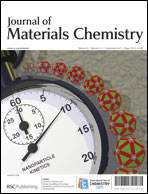Crystal structure, electronic structure, and thermoelectric properties of Ca5Al2Sb6
Abstract
The electronic structure and transport properties of Ca5Al2Sb6 are investigated by using first-principles calculations and Boltzmann transport theory, respectively. The results show that the partially filled valence band induces a high carrier concentration of about n = 5 × 1019 cm−3. There is a combination of heavy and light bands at the conduction band edge, which may lead to a combination of high Seebeck coefficient and reasonable conductivity. At mid-and-high temperature, the thermoelectric powerfactor, with respect to relaxation time of p-type Ca5Al2Sb6, is higher than that of the n-type within the carrier concentration ranging from −10 × 1021 cm−3 to 10 × 1021 cm−3, without considering the kinds of doping. But with decreasing temperature, the thermoelectric powerfactor with respect to relaxation time of n-type Ca5Al2Sb6 is higher than that of the p-type. The thermoelectric coefficient is increasingly sensitive to carrier concentration with the decreasing temperature. Most strikingly, at 30 K, the thermoelectric powerfactor, with respect to relaxation time, is nearly thirty-five times larger than that of conventional n-type thermoelectric materials. At 300 K, the thermoelectric powerfactor with respect to relaxation time of Ca5Al2Sb6 is equal to that of the conventional p-type thermoelectric materials. Our theoretical calculations give valuable insight on how to improve the thermoelectric performance of Ca5Al2Sb6 under different temperature and doping conditions.


 Please wait while we load your content...
Please wait while we load your content...